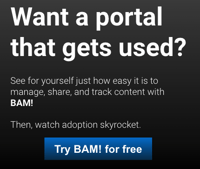In today’s competitive landscape, differentiation is key to running a profitable business … and differentiation is only successful if your customers (and potential customers) get the message. And that’s what marketing collateral is: content that describes your product, and how it’s differentiated, in a language that resonates with the target audience.
The Internet has fundamentally changed the way we approach marketing collateral. In many (if not most) markets, people turn first to the Internet to find out more about your product. Brochures, catalogs, and spec sheets have all started to appear online … but print collateral is not dead. Salespeople still rely on it, and it’s still common to have print collateral at showrooms, trade shows, and public events, and there are industries in which it’s common to mail marketing collateral to customers, distributors, and dealers.
Learn how Digital Asset Management can help your sales team >
Companies that have tried to go completely paper-free have discovered the downside of this approach. Salespeople know that showing a customer a brochure or spec sheet provides a more effective experience than saying, “It’s on the website.” Some companies have taken to handing out USB drives filled with marketing collateral at trade shows and showrooms, but what are the odds that someone will take the time to find a computer, plug in the USB drive, figure out what to open, and read the content you have invested so much time and money into?
So print collateral still has its place, but it’s vital to provide the content on your website as well. This is bad news for business: now they have to pay the cost of managing their website and print collateral. Certainly there is some overlap, such as the actual content creation, and money can be saved by letting salespeople and dealers download current marketing material and print it out locally, but you’re still ultimately paying for two mediums, when you used to only have to worry about one.
Fortunately, there is a solution. Where desktop computers (even laptops) are awkward platforms for sharing information on the sales floor or at a trade show, and smartphones are cramped, tablets have found a useful niche as a market collateral delivery channel. Not only can they be passed around like a brochure or spec sheet, but you can also invest in interactive material, such as videos, animations, and calculators. And if the potential customer wants something to take home, whatever marketing material they’re interested in can be emailed to them directly from the tablet.
“But wait,” you may be thinking, “that sounds great, but aren’t apps really expensive?” Certainly the cost of creating an app is not trivial, but consider the recurring costs of printing. There’s also a hidden cost to print collateral that most people don’t think about: the cost of ensuring your sales force, distributors, and dealers have up-to-date information. Sometimes they will be proactive, and request updated information from you, and you have to pay the transactional costs of filling those requests. And when they are not proactive, they may be losing out on sales by not having up-to-date product information.
The hidden costs are difficult to measure, but they are there. Even when we take that out of the picture, the investment in a tablet-based sales tool can pay for itself surprisingly quickly when just considering printing costs. For example, for a company with 60 products that are updated, on average, 2 times a year, that has 20 dedicated salespeople, 10 dealer/distributors, and 500 customers who receive product literature directly, investing in a tablet-based sales enablement tool pays for itself in three years (with a favorable 5-year NPV even for modest required rates of return). It’s a greener option, with less management and coordination overhead, and your sales staff always has access to up-to-date information in a way that’s easy to share with customers.
So is a sales tool right for your company? It all depends on your situation.
Download the Sales Enablement Tool Cost Model and enter the details of your company (product mix, average number of pages of marketing collateral per product, size of your sales force and distributor/dealer, printing costs) on the “Assumptions” tab. Then click over to the “Five-Year Projection” tab to see what your cost savings would be.
If a sales tool is something that will save your company money, I encourage you to check out our sales tool offerings and contact us for more information.


